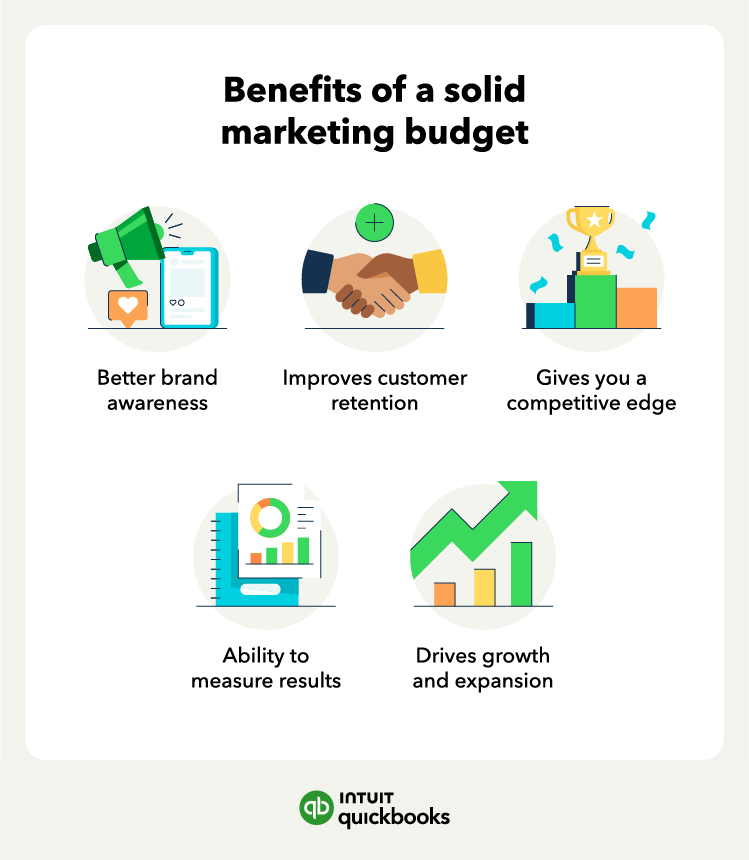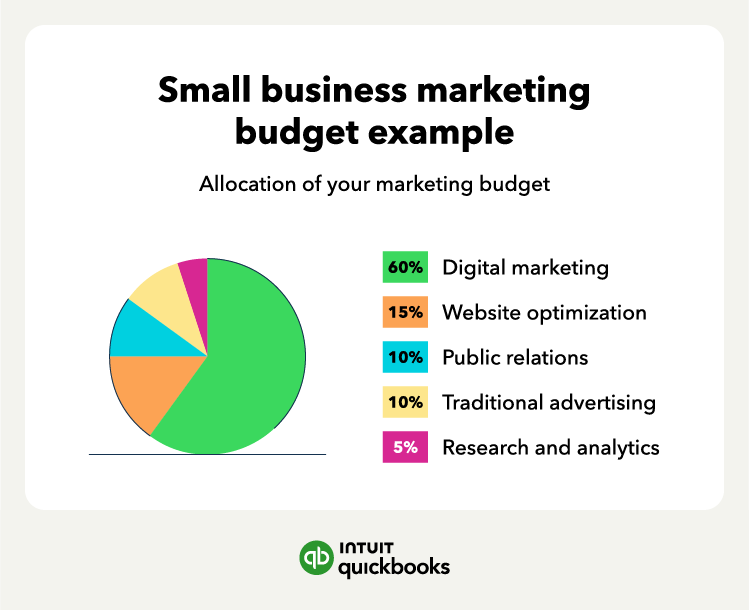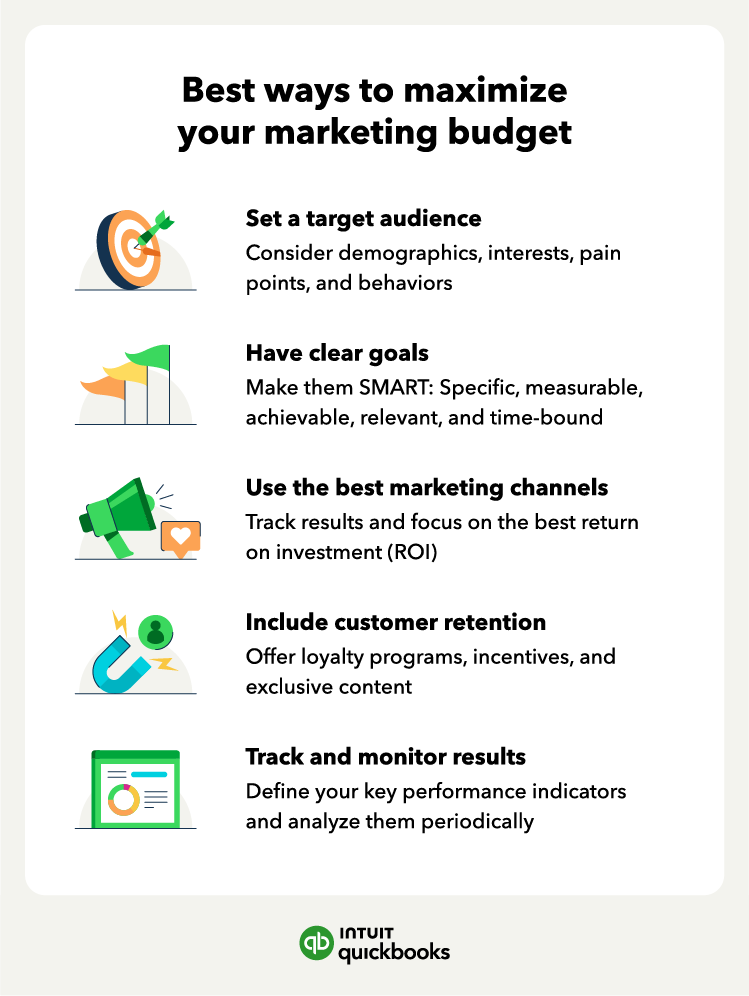When marketing your small business, you likely have plenty of questions like how much to spend and where to invest. Determining your marketing budget requires a solid marketing plan. But what works for one business may not work for another.

How to create a small business marketing budget and template
You can improve your odds of success by using a small business marketing budget to guide your marketing decisions. Let’s look at how to figure out your advertising budget with the use of a template:
Why does your business need a marketing budget?
Your small business is likely responsible for various obligations, many of which are overhead costs that you don’t have much control over. Examples include:
- Rent and utilities
- Repairs and maintenance
- Insurance
- Office supplies
- Accounting
- Taxes
- Purchasing obligations
- Loans
- Payroll
Failure to budget properly could cause you to miss your obligations. Other consequences can include things like losing licenses to conduct business if you miss certain payments. Budgets serve as the framework that guides your spending.
They help determine how much you can spend and where you can spend it. A budget plan will enable you to meet both your short-term and long-term business goals.
In particular, having a marketing and advertising budget helps new business owners to efficiently attract customers and grow revenue. Marketing budgets help you streamline and focus your marketing efforts on things that can increase your brand awareness and improve customer loyalty.

How to create a small business marketing budget
When creating a budget, you’ll want to start with figuring out your overall marketing and advertising budget, which is generally a percentage of your company's revenues such as 10%.
Identify your marketing goals
To help inform your marketing budget, you can create measurable marketing and revenue goals, such as:
- Increasing product sales by a target percentage
- Generating a set number of leads
- Hitting a target conversion rate
- Landing an ideal number of new clients
For instance, if you know that for every 100 prospects, you typically get 10 new clients, and your goal is 30 new clients, then you know you have to find 300 prospects to meet your goal. Now, look at your past marketing efforts and what competitors are doing to determine how to do that and what it'll cost.
Without well-defined marketing goals, your marketing efforts can become ineffective. Setting goals helps you understand what you want to achieve and prioritize your actions. This can help you to concentrate your resources on activities that will deliver the biggest impact.
Predict your revenue with financial forecasting
To figure out the details of your advertising budget, you’ll need to figure out your overall sales for the period you plan to budget for.
Depending on the type of business you run, you can calculate these figures for your total annual sales or individually for each product or service. If you do the latter, you’ll get a sense of how much of your marketing budget to attach to each of your offerings.
For example, if you’re working on a marketing budget for next year, forecast your sales figures for that same period. You can do this in one of four ways:
- Current sales: Use your current sales as a guideline for what your sales will be in the next year. This method will only work if you own an existing business and have prior sales. Be sure to take into account any upcoming events—such as an expansion or a discontinued product line—that might increase or decrease your sales volume.
- Projected sales: This method is ideal for startups that have no historical data to rely on. There is a bit of strategic guesswork involved with this, but forecasting revenue can put you in the right ballpark and give you an idea of how to set your budget.
- Moving average: When you average your predicted sales with your current sales, you’ll get your moving average. This method should be used if you want a conservative estimate.
- Ideal sales: This is when you set a sales volume you would like to achieve in a set period. You can base your budget on this if you want an optimistic number.
You can then use an appropriate percentage of sales to set your marketing budget. Past data will help tremendously when figuring out how to budget for future marketing expenses. If you use accounting software, a simple search will allow you to find these expenses quickly.
Use a marketing budget template
As a general guide, most small businesses spend 7% to 8% of their revenues on marketing, according to Boomcycle.
For example, if your business generates $100,000 in annual revenue, you may set your marketing budget to about 7% of that, or $7,000. Then, you’re ready to break your marketing budget into subsections.
Once you figure out how much you’ll likely spend, you’re ready to start setting and building out your budget. You can break it down into subsections depending on your industry, target audience, goals, and whether you’re selling products digitally or physically.
An example breakdown for a small business marketing budget could look like:
- Digital marketing (60%): This includes things like social media advertising, content creation, and targeted ads on places like Google. Note that small business owners can use AI to help create content and ad ideas.
- Website optimization (15%): This includes investing in search engine optimization (SEO) and user experience improvements for your website or online store.
- Public relations (10%): Budget for press releases, media outreach, events, sponsorships, and other PR activities to enhance brand visibility and reputation.
- Traditional advertising (10%): This category covers expenses for print ads, direct mail campaigns, brochures, flyers, and business cards.
- Research and analytics (5%): This includes using various tools and tactics you can use to track and improve your marketing, such as A/B testing.
Since digital marketing tends to take up over half of most businesses’ marketing budget, you can further break it down into other categories if that helps. For example, major categories under digital marketing include social media marketing, search engine marketing, and content marketing.
Let’s say your business generates $200,000 in annual sales, and you decide to set your marketing budget at 7.5% of that, or $15,000.
If you allocate 60% of that to digital marketing and 40% to other marketing strategies like traditional advertising, your marketing budget breakdown could look like:
- Digital marketing (60%) gives you $9,000 for things like SEO, paid ads, social media, and content marketing.
- Website optimization (15%) means $2,250 for improving your website or online store and keeping up with user experience improvements.
- Public relations (10%) puts $1,500 toward press relations and media relations.
- Traditional advertising (10%) means $1,500 for print advertising and direct mail campaigns.
- Research and analytics (5%) is given $750 for marketing automation platforms like Mailchimp and market studies.
However, you’ll want to make your budget template useful for your business. For example, you may choose to have your categories set up differently.
Instead of digital marketing, PR, and traditional marketing, you may have categories like:
- Paid advertising for all your ads, such as newspapers, video, email, and social media.
- Marketing collateral, which includes brochures, flyers, car wraps, catalogs, and give-away items like T-shirts or pens.
- Production costs to cover any art, design, photography, graphic art, and other expenses necessary to create your advertising.
- Technology costs to cover the cost of building and maintaining your business website and social media channels.
- Marketing automation for services to automate or outsource your marketing process.
What’s important is that you set your budget up so that you get the most out of it, which includes making it easy to track and analyze.

Tips for making the most of your marketing budget
Allocating your small business marketing budget effectively is crucial to maximizing your return on investment (ROI). Here are some actionable ideas and target allocations to consider:
- Define your target audience: Understand who your ideal customers are so you can focus your marketing efforts on reaching them effectively.
- Set clear goals: Establish Specific, Measurable, Achievable, Relevant, and Time-Bound (SMART) goals for your marketing campaigns to track their success and ensure you are investing in activities that align with your business objectives.
- Utilize effective marketing channels: Consider the marketing channels that will resonate with your potential customers, such as social media, email marketing, content marketing, and SEO.
- Don’t overlook customer retention: It’s often more cost-effective to retain existing customers than acquire new ones. Implement loyalty programs and personalized communication to keep customers engaged.
- Monitor results: Regularly track the performance of your marketing campaigns to identify what is working well and where you need to adjust.

Remember that as time goes on, your goals may change. You may begin to use new marketing tactics and phase out old ones. Consider setting both quarterly and annual budgets for your marketing spend. This will allow you to establish a more effective marketing budget, ensuring that you don’t waste money on unnecessary expenses.
Run your business with confidence
Marketing is an area where budgeting is critical. With the rise of online marketing, it’s easier than ever for you to dedicate funds to your marketing efforts. But if you’re not careful, you can find yourself spending in areas without seeing a return. Using a small business marketing budget allows you to determine how much to spend on everything from Google Ads to social media advertising.
You can then use reports and insights from accounting software like QuickBooks Online to help guide where you should be investing in marketing. A template built with your sales strategy in mind improves your marketing efforts and can go a long way in helping you grow your new business.













